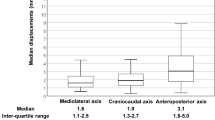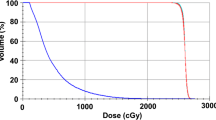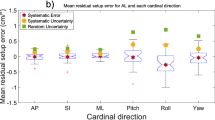Abstract
Objective
We used quantitative analytics to assess the efficiency of the clinical workflow for radiation therapy delivery in children and adults focusing on our experience with volumetric modulated arc therapy (VMAT) craniospinal irradiation (CSI).
Methods
We retrospectively collected clinical and treatment specific data between June 2013 and November 2018 for 614 VMAT CSI sessions of 41 pediatric patients and 48 VMAT CSI sessions of 6 adult patients treated at two hospitals within the same academic institution. Descriptive statistics were generated and a multiple linear regression model was created to predict total radiation time (TRT) based on these predictors. Prolonged treatment sessions were filtered using the interquartile range outlier detection method for quality assurance review.
Results
The median pediatric TRT for all VMAT CSI treatment sessions was 21.07 min (interquartile range (IQR) 9.05). Pediatric patient height, fraction number (fractions 1–3 vs. fractions > 3), and number of isocenters were significant predictors for TRT (p < 0.01). In the case of adult patients, the median TRT for all VMAT CSI treatment sessions was significantly longer at 37.23 min (IQR 45.92, p < 0.05), even in subgroup analyses comparing plans adjusted for the same number of isocenters and IGRT modality in non-sedated patients. Only in pediatric patients did the median TRT decrease after the first three treatments. Qualitative causal factor analysis revealed plausible causes for prolonged TRT as anxiety, anticipatory nausea and vomiting, challenging setups, anesthesia tolerance, and delay to allow for physician online IGRT review of setup.
Conclusions
Simple descriptive statistics and regression modeling can be used to assess workflow efficiency and estimate radiation treatment times based on patient and technique-specific factors. We modeled VMAT CSI treatment delivery times at our pediatric and adult hospitals to set time expectations for IGRT and beam delivery. Workflow analytics can identify opportunities to minimize time inefficiencies and optimize coordination of care.


Similar content being viewed by others
References
Zabel-du Bois A, Milker-Zabel S, Bruns F, Christiansen H, Ernst I, Willich N, Popp W, Debus J, Sack H (2014) Evaluation of time, attendance of medical staff and resources for radiotherapy in pediatric and adolescent patients. The DEGRO-QUIRO trial. Strahlenther Onkol Organ Dtsch Rontgengesellschaft Al 190(6):582–590. https://doi.org/10.1007/s00066-014-0619-z
Shinder GA, Paradis PE, Posman M, Mishagina N, Guay MP, Linardos D, Batist G (2012) Patient and work flow and costs associated with staff time and facility usage at a comprehensive cancer centre in Quebec, Canada--a time and motion study. BMC Health Serv Res 12:370. https://doi.org/10.1186/1472-6963-12-370
Stübig T, Zeckey C, Min W, Janzen L, Citak M, Krettek C, Hüfner T, Gaulke R (2014) Effects of a WLAN-based real time location system on outpatient contentment in a level I trauma center. Int J Med Inf 83(1):19–26. https://doi.org/10.1016/j.ijmedinf.2013.10.001
Conley K, Chambers C, Elnahal S, Choflet A, Williams K, DeWeese T, Herman J, Dada M (2018) Using a real-time location system to measure patient flow in a radiation oncology outpatient clinic. Pract Radiat Oncol 8(5):317–323. https://doi.org/10.1016/j.prro.2018.04.015
Hamrock E, Paige K, Parks J, Scheulen J, Levin S (2013) Discrete event simulation for healthcare organizations: a tool for decision making. J Healthc Manag Am Coll Healthc Exec 58(2):110 -124-125
Croft AM, Lynch P, Smellie JS, Dickinson CJ (1998) Outpatient waiting times: indicators of hospital performance? J R Army Med Corps 144(3):131–137
Werker G, Sauré A, French J, Shechter S (2009) The use of discrete-event simulation modelling to improve radiation therapy planning processes. Radiother Oncol J Eur Soc Ther Radiol Oncol 92(1):76–82. https://doi.org/10.1016/j.radonc.2009.03.012
Wong KK, Ragab O, Tran HN, Pham A, All S, Waxer J, Olch AJ (2018) Acute toxicity of craniospinal irradiation with volumetric-modulated arc therapy in children with solid tumors. Pediatr Blood Cancer 65:e27050. https://doi.org/10.1002/pbc.27050
Hazrati S, Hourigan SK, Waller A, Yui Y, Gilchrist N, Huddleston K, Niederhuber J (2016) Investigating the accuracy of parentally reported weights and lengths at 12 months of age as compared to measured weights and lengths in a longitudinal childhood genome study. BMJ Open 6(8):e011653. https://doi.org/10.1136/bmjopen-2016-011653
Author information
Authors and Affiliations
Corresponding author
Ethics declarations
Conflict of interest
The authors declare that they have no conflict of interest.
Ethical approval
All procedures followed were in accordance with the ethical standards of the responsible committee on human experimentation (institutional and national) and with the Helsinki Declaration of 1975, as revised in 2008.
Informed consent
This article does not contain any studies with identifiable or protected data from human or animal subjects performed by any of the authors.
Statistical analyses
Steven M. Nguyen, MD, and Christophe Marques, MD
Additional information
Publisher’s note
Springer Nature remains neutral with regard to jurisdictional claims in published maps and institutional affiliations.
Rights and permissions
About this article
Cite this article
Nguyen, S.M., Weng, J.K., Sison, J. et al. Volumetric modulated craniospinal irradiation workflow optimization through quantitative analytics: a single-institution case study comparing pediatric and adult settings. J Radiat Oncol 9, 113–121 (2020). https://doi.org/10.1007/s13566-020-00429-9
Received:
Accepted:
Published:
Issue Date:
DOI: https://doi.org/10.1007/s13566-020-00429-9




